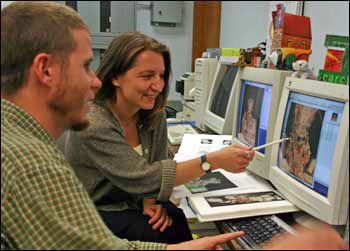Professor Zsuzsanna Gulacsi’s ability to decipher historic art as well as text is opening doors for the world to have a better understanding of medieval cultures.
Gulacsi is an internationally known expert on Iranian and Turkic illuminated book fragments from the eighth to the 11th centuries found in East Central Asia. The NAU art history professor will take time off from teaching next year to further research the artistic connections among early Christian, Islamic and Manichaean cultures.
Gulacsi recently received an American Council of Learned Societies Charles A. Ryskamp Research Fellowship that will provide a $64,000 stipend. She also received additional travel funding through a Residential Fellowship at the National Humanities Center in North Carolina and the Franklin Research Grant of the American Philological Society of Philadelphia.
“I follow a holistic approach in my research,” Gulacsi said. “I analyze surviving book fragments to determine how the relationship of the text and visual components can help us gain an understanding about art, history and culture.”
The Hungarian-born professor has been researching Central and West Asian book fragments for more than a decade. Trained as both an art historian and an area studies specialist, she continues to publish and lecture internationally about the formation of medieval book art in West and Central Asia, a region stretching from the Eastern Mediterranean to the western frontier of China. Recording and analyzing the data was only the first step for Gulacsi, who is now ready to put her unique skills to work interpreting her sources in their contemporaneous art historical setting.
Even though there is art involved, Gulacsi takes a scientific approach to her work. She records every tidbit of information about each book fragment so she can explore the connections in hope of uncovering more about “a time when Christian, Islamic and Manichaean cultures coexisted harmoniously.”
“I don’t gather data for data’s sake,” she said. “Since all my sources are fragments that retain precious little from a once glorious book culture, scientific means such as radiocarbon dates, chemical analysis, microscopic examination, measurements, as well as tables and diagrams are useful research tools. Through them one can discover patterns in the sources and thus gain new knowledge about the material and technical aspects of this art. A colleague called my approach ‘forensic book archaeology’—that is exactly what it is.”
Gulacsi discovered the correlation between sideways illuminations in Christian, Islamic and Manichaean illuminated books and religious teachings. She credits the first Manichaean community in third century Mesopotamia for introducing images to their religious teachings in formats of picture books aimed for those who could not read.
Restoring the artwork to its original grandeur is also helping Gulacsi’s research. She spends hours at NAU’s Bilby Research Center working with advanced imaging systems to re-create the illustrations she calls “illuminations.”
Her 2005 book, Mediaeval Manichaean Book Art: A Codicological Study of Iranian and Turkic Illuminated Book Fragments from the 8th – 11th cc. East Central Asia, is an analysis of 107 manuscript fragments, in terms of their book formats, painting styles, as well as textual and artistic content.
Gulacsi has master’s degrees and a Ph.D. in both art history and Central Eurasian Studies from Indiana University. She also earned a master’s degree in historical ethnography from Lorand Eotvos University in Budapest.
For a complete list of Gulacsi’s accomplishments, go to www.nau.edu/human/people/gulacsi.htm.



